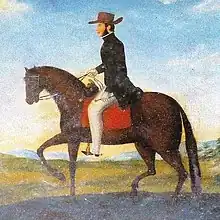The Salvadoran Campaign of 1832 or the Salvadoran Rebellion of 1832 was a military conflict in El Salvador in 1832.
| Salvadoran Campaign of 1832 | |||||||
|---|---|---|---|---|---|---|---|
| Part of Restoration Plan War 1832 | |||||||
 Francisco Morazán | |||||||
| |||||||
| Combatants | |||||||
|
| |||||||
| Commanders and leaders | |||||||
|
|
| ||||||
Conflict
In 1832, public order was disturbed, as revolutionary movements broke out, almost at the same time, in three places in the Republic of El Salvador, on the coasts of the Northern Honduras and in Soconusco, whose plan was forged by people from the party that fell in Guatemala in 1829, supported by Archbishop Fray Ramón Casaus y Torres, who was exiled in Havana.
When President Morazán learned of that the Head of El Salvador, Jose Maria Cornejo, agrees with the conservatives estranged from the country, and conspires to change the order of things established by triumph of the liberal party in 1829, he moved to Santa Ana, on January 1832 , where he received, from the rebel leader, a strict order to leave that territory.
In view of such strange behavior, the Federal Congress authorized the President to reduce by arms the Chief Cornejo, who was already threatening to subtract the State from the Federal Pact. General Morazán, with enough troops, and aided effectively by the governments of Guatemala and Nicaragua, chaired by Dr. Gálvez and Dionisio Herrera respectively, he marched to El Salvador, defeated Cornejo, on the following March 14 in the plains of Jocoro, and forced him to take refuge in the capital of the State, which decided to defend at all costs.[1][2][3]
The federals attacked the city, by Milingo, Soyapango and Agua Caliente, and after two hours of close fighting, in the streets of the town, they took over the city on March 28, 1832, and Cornejo and his main chiefs and officers, who were sent to Guatemala.[4]
Further reading
References
- ↑ Vera, Robustiano (1899). Apuntes para la historia de Honduras (in Spanish). Imp. de "El Correo,".
- ↑ Nicaragua (1873). Código de la lejislacion de la República de Nicaragua en Centro-America (in Spanish). Imprenta de "El Centro-Americano".
- ↑ Argueta, Mario (1999). La primera generación liberal: fallas y aciertos (1829-1842) (in Spanish). Banco Central de Honduras. ISBN 978-99926-11-02-9.
- ↑ C, José Antonio Villacorta Calderón Villacorta (1916). Curso de historia de la América Central para uso de los institutos y escuelas normales (in Spanish). Arenales hijos.